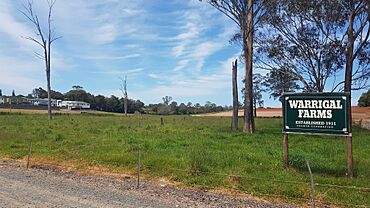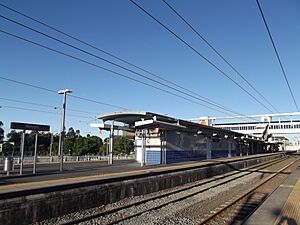Runcorn, Queensland facts for kids
Quick facts for kids RuncornBrisbane, Queensland |
|||||||||||||||
|---|---|---|---|---|---|---|---|---|---|---|---|---|---|---|---|

Warrigal Farms, 2022
|
|||||||||||||||
| Population | 14,199 (2021 census) | ||||||||||||||
| • Density | 2,184/km2 (5,660/sq mi) | ||||||||||||||
| Established | 1868 | ||||||||||||||
| Postcode(s) | 4113 | ||||||||||||||
| Area | 6.5 km2 (2.5 sq mi) | ||||||||||||||
| Time zone | AEST (UTC+10:00) | ||||||||||||||
| Location | 17.2 km (11 mi) SSE of Brisbane CBD | ||||||||||||||
| LGA(s) | City of Brisbane (Runcorn Ward) |
||||||||||||||
| State electorate(s) |
|
||||||||||||||
| Federal Division(s) | Moreton | ||||||||||||||
|
|||||||||||||||
Runcorn is a suburb located in the southern part of Brisbane, Queensland, Australia. It is a busy and diverse area. In 2021, about 14,199 people lived there.
Contents
Exploring Runcorn's Location
Runcorn is about 18.6 kilometers (11.6 miles) by road from Brisbane's main city center. Two important roads, Beenleigh Road and Warrigal Road, go through the suburb. These roads connect Runcorn to the city and other places.
A large part of Runcorn is next to Bulimba Creek. This creek also starts within the suburb itself.
A Look Back at Runcorn's History
Early Days and Naming
Long ago, the Jagera Aboriginal people lived on the land south of the Brisbane River. The area that is now Runcorn was part of their territory.
In 1868, the Williams family were the first European settlers in the area. A decade later, Reverend J. McLaren moved there. He named his farm "Runcorn" after a town in England called Runcorn, Cheshire.
Farming and Growth
In the 1870s, people started growing cotton and other small crops. The area was mostly farms, with fruit and vegetable growers, chicken farms, and dairy farms.
In 1885, the Beenleigh railway line opened. This made it easier for people and goods to travel. The Runcorn railway station was built to serve the area.
A factory called the Runcorn Bone Mill started in 1886. It made fertilizer from bones. Farmers from far away, even New Zealand, used this fertilizer. The mill was later used by the United States Army and British Navy during World War II.
Schools and Community
Runcorn Provisional School opened on 8 July 1901 with 26 students. It became Runcorn State School in 1909. The school grew a lot, with nearly 400 children by 1929.
Later, two more schools opened:
- Runcorn Heights State School opened in 1975.
- Runcorn State High School opened in 1986.
The Runcorn Progress Hall was built in 1926. It became a central place for the community. People held dances, parties, and other social events there.
Modern Runcorn
In the 1960s, Runcorn started to develop quickly. Many new homes were built, and the number of people living there grew a lot.
Who Lives in Runcorn?
Runcorn is a very diverse suburb, meaning people from many different backgrounds live there. In 2021, the population was 14,199 people.
About 42.6% of people in Runcorn were born in Australia. Many others were born in countries like China, India, Korea, and Taiwan.
Many different languages are spoken at home. While 59.4% speak only English, other common languages include Mandarin, Punjabi, and Cantonese. The average age of people in Runcorn is 34 years old.
Learning in Runcorn
Runcorn has several schools for students of different ages.
Runcorn Heights State School
This is a government primary school for students from Prep to Year 6. It is located at 200 Nemies Road. The school also has a special education program.
Runcorn State High School
This is a government secondary school for students from Year 7 to Year 12. It is located at 132 Hill Road. It also offers a special education program.
Even though Runcorn State School has "Runcorn" in its name, it is now actually in the nearby suburb of Sunnybank Hills. However, it still helps educate children from the northern part of Runcorn.
Fun Things to Do in Runcorn
Runcorn has several shopping centers where you can find many different things. It's a popular place for students because it's close to Sunnybank and has good rental prices.
Warrigal Road Farm is one of the oldest farms in the area, operating for over 100 years. The Runcorn Horse and Pony Club also offers fun activities with horses.
The Brisbane City Council looks after 33 parks in Runcorn. These parks have facilities for picnics, barbecues, basketball, cricket, and cycling. There is also a public swimming pool in the suburb.
Runcorn is home to the Souths United football (soccer) club. They play in the Football Queensland Premier League.
St Laurence's College also has playing fields in Runcorn. These fields are used for sports like cricket, football, and rugby.
Getting Around Runcorn
Train Services
The main train line that goes between Brisbane and the Gold Coast, Queensland runs through Runcorn. Queensland Rail operates this line.
Runcorn has two train stations:
- Runcorn Station
- Fruitgrove Station
These stations offer services that stop at all stations or express services between Brisbane and Beenleigh. However, trains going to the Gold Coast do not stop at these stations.
Bus Services
Runcorn is also served by Translink buses. The main bus route is the 150, which runs frequently throughout the day. Other bus routes, like the 152, 153, 156, and P157, also pass through Runcorn.
Famous People from Runcorn
Alfred Williams
Alfred Williams was the first European settler in Runcorn in 1868. His family started a nursery called Green Hill, which specialized in rose and fruit trees. Alfred was also involved in local government.
Lily Hair
Lily Hair moved to Brisbane from England in 1920. She and her husband, Bob, settled in Runcorn. They were very active in the community. Lily worked to get electricity for the area and helped open a small post office in her home in 1957. She ran the post office until 1971.
Gordon Olive
Gordon Olive was a fighter pilot during World War II. He became a high-ranking officer in the Royal Australian Air Force. After the war, he bought a farm in Runcorn. He was also involved in programs like Outward Bound and the Duke of Edinburgh Scheme.



